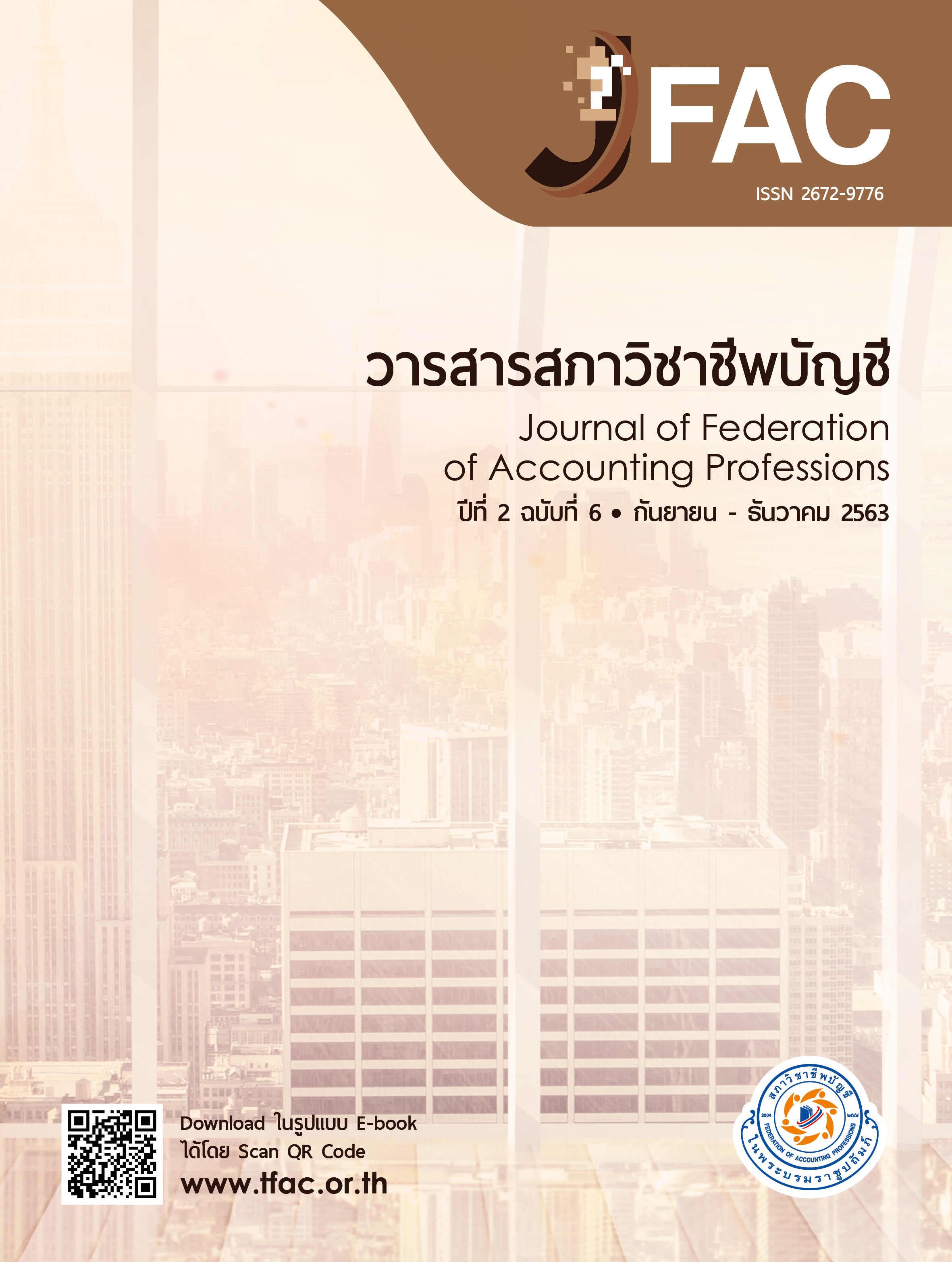เมจิกฟอร์มูล่ากับการลงทุนแบบเน้นคุณค่าในตลาดหลักทรัพย์แห่งประเทศไทย
Main Article Content
บทคัดย่อ
งานวิจัยนี้ศึกษาว่าการเลือกหลักทรัพย์ลงทุนโดยการใช้กลยุทธ์ Magic Formula สามารถสร้างผลตอบแทนเกินปกติหรือไม่ และการนำข้อมูลเชิงคุณภาพมาพิจารณาร่วมด้วย จะสามารถสร้างผลตอบแทนที่มากกว่าการพิจารณาแค่กลยุทธ์ Magic Formula เพียงอย่างเดียวหรือไม่ สำหรับการลงทุนแบบเน้นคุณค่า ซึ่งเป็นการทำกำไรจากการประเมินมูลค่าหลักทรัพย์ผิดพลาด (Mispricing) โดยในงานวิจัยนี้จะแบ่งการลงทุนออกเป็น 2 กลยุทธ์ คือ (1) พิจารณาจากกลยุทธ์ Magic Formula เพียงอย่างเดียว (2) พิจารณาจากกลยุทธ์ Magic Formula ประกอบกับรายงานสรุปภาวะตลาดหลักทรัพย์ประจำเดือน ซึ่งเป็นตัวแทนของข้อมูลเชิงคุณภาพ แต่ละกลยุทธ์จะประกอบด้วยหลักทรัพย์จำนวน 10, 20, 30 และ 40 หลักทรัพย์ในพอร์ทการลงทุน รวมทั้งสิ้น 8 พอร์ทการลงทุน และมีกลุ่มตัวอย่าง คือ หลักทรัพย์ที่อยู่ในตลาดหลักทรัพย์แห่งประเทศไทย (SET) ตั้งแต่ พ.ศ. 2552 – 2561
จากการศึกษาในรอบระยะเวลา 10 ปี ตั้งแต่ พ.ศ. 2552 – 2561 พบว่า การลงทุนโดยการพิจารณาจากกลยุทธ์ Magic Formula ประกอบกับรายงานสรุปภาวะตลาดหลักทรัพย์ประจำเดือน ที่มีจำนวนหลักทรัพย์ 20 หลักทรัพย์ และเมื่อคำนวณตามหลักเกณฑ์ Magic Formula แล้วมี Magic Formula Score ที่ไม่เกิน 30 คะแนน จะทำให้ได้รับผลตอบแทนและผลตอบแทนต่อความเสี่ยง (Sharpe ratio) สูงที่สุด นอกจากนี้ ยังมีหลักฐานเชิงประจักษ์ว่า การพิจารณาถึงข้อมูลเชิงคุณภาพร่วมกับกลยุทธ์ Magic Formula ทำให้ได้ผลตอบแทนที่มากกว่าการพิจารณาเพียงกลยุทธ์ Magic Formula ซึ่งเป็นข้อมูลเชิงปริมาณเพียงอย่างเดียว และทุกพอร์ทการลงทุนมีผลตอบแทนต่อความเสี่ยง (Sharpe ratio) มากกว่าตลาดหลักทรัพย์แห่งประเทศไทย (SET)
Article Details
เนื้อหาและข้อมูลในบทความที่ลงตีพิมพ์ในวารสารสภาวิชาชีพบัญชี ถือเป็นข้อคิดเห็นและความรับผิดชอบของผู้เขียนบทความโดยตรงซึ่งกองบรรณาธิการวารสารไม่จำเป็นต้องเห็นด้วยหรือร่วมรับผิดชอบใด ๆ
บทความ ข้อมูล เนื้อหา รูปภาพ ฯลฯ ที่ได้รับการตีพิมพ์ในวารสารสภาวิชาชีพบัญชี ถือเป็นลิขสิทธิ์ของวารสารสภาวิชาชีพบัญชี หากบุคคลหรือหน่วยงานใดต้องการนำข้อมูลทั้งหมดหรือบางส่วนไปเผยแพร่ต่อหรือเพื่อกระทำการใดๆ จะต้องได้รับอนุญาตเป็นลายลักษณ์อักษรจากวารสารสภาวิชาชีพบัญชี ก่อนเท่านั้น
เอกสารอ้างอิง
ภาษาไทย
อุรสา บรรณกิจโศภน. (2553). ปัจจัยที่มีผลต่อการตัดสินใจลงทุนในตลาดหลักทรัพย์แห่งประเทศไทย ; Factors affecting investment decision making in the stock exchange of Thailand (วิทยานิพนธ์). กรุงเทพมหานคร: สถาบันบัณฑิตพัฒนบริหารศาสตร์.
ภาษาอังกฤษ
Barber, B. M., & Lyon, J. D. (1997). Detecting long-run abnormal stock returns: The empirical power and specification of test statistics. Journal of Financial Economics, 43(3), 341-372.
Barberis, N., Shleifer, A. & Vishny, R. (1998). A model of investor sentiment. Journal of Financial Economics, 49, 307-343.
Ball, Ray., & Brown, Plilip. (1968). An Empirical Evaluation of Accounting Income Numbers. Journal of Accouting Research, Autumn (1968), 159-177.
Basu, S. (1977). Investment performance of common stocks in relation to their price-earnings ratios: A test of the efficient market hypothesis. The Journal of Finance, 32(3), 663-682.
Bird, R., & Casavecchia, L. (2007). Sentiment and financial health indicators for value and growth stocks: The European experience. The European Journal of Finance, 13(8), 769-793.
Borges, M. R. (2010). Efficient market hypothesis in European stock markets. The European Journal of Finance, 16(7), 711-726.
Brown, S., & Warner, J. (1985). Using Daily Stock Returns: The Case of Event Studies.
Journal of Financial Economics, 14(1985), 3-31.
Catalyst Capital Advisors LLC. (2013). A guide to the Magic Formula investment strategy. Retrieved from https://catalystmf.com/spotlights/investors-choice-awards-nominates-two-catalyst-funds/.
Chan, L. K., & Lakonishok, J. (2004). Value and growth investing: Review and update. Financial Analysts Journal, 60(1), 71-86.
Choi, B. P., & Mukherji, S. (2010). Optimal portfolios for different holding periods. Journal of Business & Economics Research (JBER), 8(10).
Dhatt, M.S., Kim, Y.H. & Mukherji, S. (1999). The Value Premium for Small-Capitalization Stocks, Financial Analysts Journal, 55(5)5, 60-68.
Dhatt, M. S., Kim, Y. H., & Mukherji, S. (2004). Can composite value measures enhance portfolio performance? The Journal of Investing, 13(4), 42-48.
Elisa, H., Jelena, P., & Rickard, P. (2013). Value relevance of accounting information and its impact on stock prices: Evidence from Sweden. Department of Economics, Stockholm University. Sweden.
Fama, E. F., & French, K. R. (1992). The cross-section of expected stock returns. The Journal of Finance, 47(2), 427-465.
Graham, Benjamin. (1949). The Intelligent Investor. New York: Harper & Brothers.
Greenblatt, J. (2006). The little book that beats the market. Hoboken, New Jersey: John Wiley & Sons.
Greenblatt, J. (2010). The little book that still beats the market. Hoboken, New Jersey: John Wiley & Sons.
Greenblatt, J. (1997). You Can Be a Stock Market Genius. New York: Simon & Schuster.
Ohlson, J. A. (1995). Earnings, book values and dividends in security valuation. Contemporary Accounting Research, 11, 661-687.
Olin, Tomi. (2011). Value investing in the Finnish stock market (Master’s thesis). Alto University, Espooo, Finland.
Peeratiyuth, Koedkao. (2020). Update: Magic Formula สูตรการลงทุนอันแสนมหัศจรรย์ของ Joel Greenblatt, Retrieved from https://www.siamquant.com/magic-formula-update-2020/.
Philip, V. & Tim du Toit. (2014). Quantitative Value Investing in Europe: What works for achieving alpha. Retrieved from https://www.amazon.com/Quantitative-Value-Investing-Europe-achieving-ebook/dp/B00M8B01EE.
Piotroski, J. D. (2000). Value investing: The use of historical financial statement information to separate winners from losers. Journal of Accounting Research, 38, 1-41.
Postma, P.P.M. (2015). Magic Formula investing in the Benelux (Bachelor thesis). Tilburg University, Tilburg, Netherlands.
Rousseau, R., & Rensburg, P. V. (2003). Time and the payoff to value investing. Journal of Asset Management, 4(5), 318-325.
Valencia, H., Lorenzo, V., & Duran, V., (2007). Value Relevance of the Ohlson model with Mexican data. Contaduría y Administración, septiembre-diciembre, 223, 33-52.
Sareewiwatthana, P. (2013). Common financial ratios and value investing in Thailand. Journal of Finance and Investment Analysis, 2(3), 69-85.
Sareewiwatthana, P. (2015). Value investment in Thailand: Optimal number of stocks and holding period. NIDA Business Journal, 16(2), 5-25.


